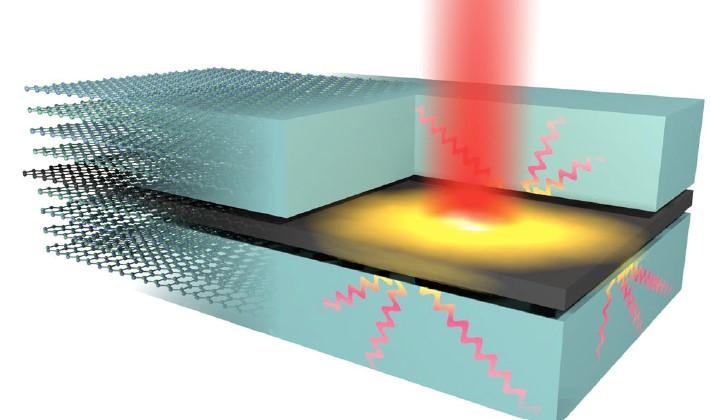

Schematic representation of the highly efficient out-of-plane heat transfer from graphene hot electrons (yellow glow), created by optical excitation (red beam), to hyperbolic phonon-polaritons in hBN (wave lines).
Credit: ICFO
Nanoscale heat flow plays a crucial role in many modern electronic and optoelectronic applications, such as thermal management, photodetection, thermoelectrics and data communication. Two-dimensional layered materials are beginning to confirm their groundbreaking role in many of these applications. Perhaps even more promising are so-called van der Waals heterostructures, consisting of different layered two-dimensional materials stacked one on top of the other. These stacks can consist of materials with dramatically different physical properties, while the interfaces between them are ultraclean and atomically sharp.
Scientists from the European Graphene Flagship, led by ICFO researchers, have recently succeeded in observing and following, in real-time, the way in which heat transport occurs in van der Waals stacks, which consist of graphene encapsulated by the dielectric two-dimensional material hexagonal BN (hBN).
In a study, recently published in Nature Nanotechnology entitled “Out-of-plane heat transfer in van der Waals stacks through electron-hyperbolic phonon coupling”, ICFO researchers Klaas-Jan Tielrooij, Niels C. H. Hesp, Mark B. Lundeberg, Mathieu Massicotte, Peter Schmidt, and Diana Davydovskaya, led by ICREA Prof at ICFO Frank Koppens, in collaboration with researchers from The Netherlands, Italy, Germany, and United Kingdom, have identified a highly surprisingly effect: rather than staying within the graphene sheet, the heat actually flows to the surrounding hBN sheets. This out-of-plane heat transfer process occurs on an ultrafast timescale of picoseconds (one millionth of a millionth of a second), and is therefore dominant over competing (in-plane) heat transfer processes.
The heat transfer process occurs through hot graphene electrons (experimentally generated by incident light) that couple to hyperbolic phonon-polaritons in the hBN sheets. These phonon-polaritons propagate within the hBN as light does in an optical fiber, but in this case for infrared wavelengths and at the nanometer scale. It turns out that these exotic hyperbolic modes are very efficient at carrying heat away.
The results of this work will definitely have far-reaching implications for many applications based on hBN-encapsulated graphene, sometimes referred to as the next generation graphene platform, owing to its superior electrical properties. In particular, it will provide direction to optoelectronic device design, where these heat flow processes can be thoroughly exploited.
###
REFERENCE
Out-of-plane heat transfer in van der Waals stacks through electron-hyperbolic phonon coupling, Nature Nanotechnology.
K. J. Tielrooij, and F. H. L. Koppens.
DOI: 10.1038/s41565-017-0008-8
Link to the paper: https:/
Link to graphene at ICFO: http://graphene.
Link to the research group led by ICREA Professor at ICFO Frank Koppens: https:/
FUNDING INFO
This work was funded by the E.C. under Graphene Flagship, as well as a Mineco Young Investigator grant.
ABOUT ICFO:
ICFO – The Institute of Photonic Sciences, member of The Barcelona Institute of Science and Technology, is a research center located in a specially designed, 14.000 m2-building situated in the Mediterranean Technology Park in the metropolitan area of Barcelona. It currently hosts 400 people, including research group leaders, post-doctoral researchers, PhD students, research engineers, and staff. ICFOnians are organized in 27 research groups working in 60 state-of-the-art research laboratories, equipped with the latest experimental facilities and supported by a range of cutting-edge facilities for nanofabrication, characterization, imaging and engineering.
The Severo Ochoa distinction awarded by the Ministry of Science and Innovation, as well as 14 ICREA Professorships, 25 European Research Council grants and 6 Fundació Cellex Barcelona Nest Fellowships, demonstrate the centre's dedication to research excellence, as does the institute's consistent appearance in top worldwide positions in international rankings. From an industrial standpoint, ICFO participates actively in the European Technological Platform Photonics21 and is also very proactive in fostering entrepreneurial activities and spin-off creation. The center participates in incubator activities and seeks to attract venture capital investment. ICFO hosts an active Corporate Liaison Program that aims at creating collaborations and links between industry and ICFO researchers. To date, ICFO has created 6 successful start-up companies.















